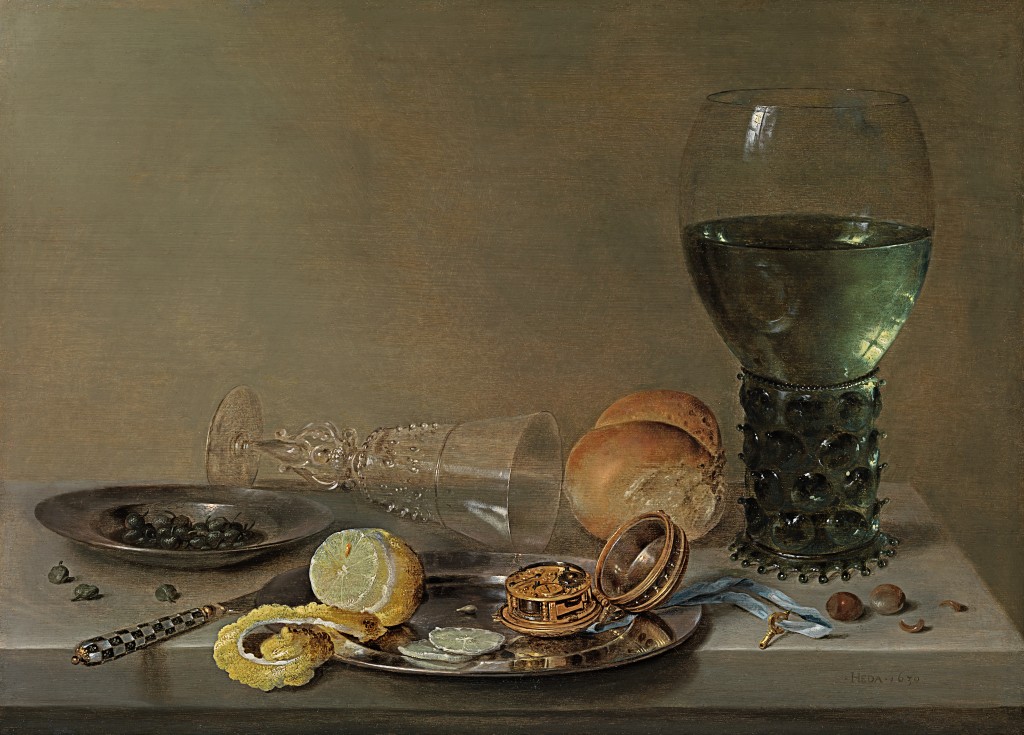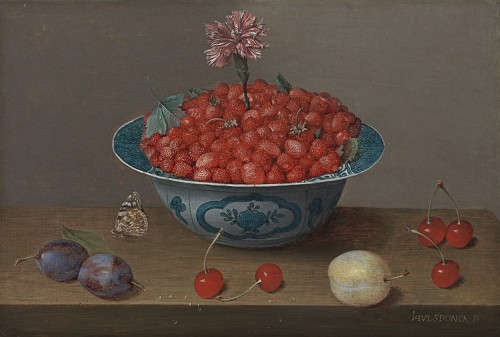WILLEM CLAESZ HEDA
1594 – Haarlem - 1680
Ref: CB 133
A still life of a rummer of white wine, a mother-of-pearl inlaid knife, a gilt-brass clockwatch with a blue ribbon, a pewter plate with capers, a peeled lemon and a façon-de-Venise wineglass on a table
Signed and dated lower right: . HEDA . 1630
Oil on panel: 16 3/8 x 22 ½ in / 41.6 x 57.2 cm
Frame size: 28 ¼ x 22 ½ in / 71.8 x 57.2 cm
Provenance:
Frederik Muller, 14th May 1912, lot 122;
Frans Smulders Collection;
his sale, Galerie Royale Kleykamp, The Hague, 9th November 1937, lot 2, illus.
Private collection, Europe, for two generations
Sotheby’s Amsterdam, 11th November 2008, lot 39
Private collection, Europe
Exhibited:
Haarlem, Frans Hals Museum, on loan 1998-2008
Niigata Bandaijima Art Museum/Toyohashi, City Museum of Art and History/Sakura City Museum of Art, Dutch Art in the Age of Frans Hals from the Collection of the Frans Hals Museum, 2003-4, no.55
Haarlem, Frans Hals Museum/Zurich, Kunsthaus/Washington DC, National Gallery of Art, Pieter Claesz.: Meester van het Stilleven in de Gouden Eeuw, 2004-5
Willem Claesz. Heda, along with his near-contemporary Pieter Claesz. (1596/97-1660), transformed the Dutch still life from the widely spaced compositions and bright local colours of exponents such as Floris van Dijck (1575-1651), to develop the ‘monochrome ontbijtje’ or ‘breakfast piece’. Both painters spent their career in Haarlem, a prosperous town with important brewing and textile industries. The wealthy bourgeoisie were discerning patrons of the arts. Paintings such as this Still life of a rummer were displayed in the public rooms of merchants’ mansions, evidence of the owner’s good taste.
Heda began painting still lifes in the mid-1620s, but it was only at the end of the decade that he adopted a lower, more intimate viewpoint in his compositions, unifying the objects by means of tonal affinities. Set against a plain, gently-shadowed grey-green background, a meal is placed on a stone ledge. Grey, silver and pewter tones ripple across the panel, intercut with touches of gold: the reflection of sunlight through the studio window in the rummer, the gilt-brass clockwatch and the glistening curl of the cut lemon peel. The blue ribbon of the clockwatch’s winding key provides a bright element of contrasting colour in the foreground.
All the objects, with the exception of the large rummer, physically overlap, moving the eye across different textures and colours. Though in fact carefully placed, the elements evoke a sense of informality, even haste. The clockwatch is left open, revealing its complex movement; the delicate façon-de-Venise wineglass is tipped on its side, as if a diner has left the table in a hurry.
As with many of Pieter Claesz.’s still lifes, the scene here is probably an ontbijt, an informal meal served around eleven in the morning, at which guests helped themselves. Heda revels in the way that light plays across the varied elements of his composition, from the complex reflections in the bowl of the rummer, to the glitter of light on its prunts, the dull silver-grey of the pewter plates, the sheen of the clockwatch and silk ribbon and the knobbly, golden lemon peel. Shapes harmonize across the panel, the oval rim of the rummer picked up in the forms of the pewter plates, clockwatch case and sliver of lemon. The complexity of the clockwatch movement is echoed in the complex spiral of lemon peel, the ingenuity of man balanced against the inexhaustible richness of nature.
Heda often included high-status objects in his still lifes, here notably the clockwatch and knife. The clockwatch dates from c.1600-1620: its stackfreed movement, visible in Heda’s meticulous delineation, indicates that it was almost certainly made in south Germany, probably Nuremberg or Augsburg (other countries tended to use the more efficient fusee)[1]. Clockwatches of this date would have cost multiples of a workman’s annual wage. They were showy toys for the rich, sometimes worn about the person, in a silk bag on a belt, but just as often artfully arranged on a table, to impress visitors. With a single hand, they struck the hours on a bell, but were very inaccurate and had to be reset every day. Heda lavishes painterly care on the intricate steel and gilt-brass case, the most glamorous object in the still life.
The knife is similarly a luxury object, which would have formed part of a small travelling knife and fork set, treasured objects often kept in a case. It appears, set at a similar angle on the edge of a table, in Still life with goblet, 1631, in the Wadsworth Atheneum, Hartford, CT. The knife, lemon peel and pewter plate, protruding beyond the edge of the table, create a brilliant trompe l’oeil effect.
The façon-de-Venise wineglass, probably produced in the Netherlands to emulate the complex vessels produced by the Murano glass factories, is captured by Heda in all its ethereal complexity and transparency. Tipped on its side, but unbroken, it perhaps warns against luxury and hints at the fragility of worldly things.
The food in the painting is in keeping with the high-status objects. The roll is highly refined white bread, while the majority of the population would have made do with cheaper brown rye.
Lemons were tender, luxury fruits, imported from the Mediterranean or raised in orangeries by the wealthy[2].
The open clockwatch was a motif especially favoured by Heda. In 1629, the year before the present painting was made, he depicted a similar open watch, with a blue ribbon but different case decoration, in Still life with roemer and watch in the Mauritshuis, The Hague. Another clockwatch appears in a much later work, Still life with a nautilus cup, 1640 (Suermondt-Ludwig-Museum, Aachen). It is impossible to know whether Heda owned such a valuable watch. He was from a prosperous family, the son of Haarlem’s City Architect, but the clockwatch could have been borrowed from a patron or a clockmaker’s collection and studied in a drawing which would have been kept in the studio for reference. Heda may have been inspired to include an open watch by seeing works by Pieter Claesz., who frequently included watches in his compositions. Claesz.’s painting Two peaches, a watch, a rummer filled with wine and other objects on a draped table, signed and dated 1627 (private collection)[3] features a watch and winding key in the foreground, as does his Vanitas still life with violin and glass ball, c.1628 (Germanisches Nationalmuseum, Nuremberg)[4]. The two artists were undoubtedly in contact, as objects such as an elaborate silver tazza appear in both of their works[5].
Watches and clocks in seventeenth century Dutch paintings often carry the notion of time flying, of vanitas. In this work, the fallen wineglass denotes haste and perhaps overindulgence. It is balanced by the lemon, used to temper the taste of wine and a symbol in paintings of an encouragement to a moderate life. Heda’s still life, with its gentle, interlocked tones and calm echoes of ovals and curves, at once conjures up the mutable, material world and suspends it in time through the genius of his art.
Susan Morris
William Claesz. Heda, Still life with roemer and watch, signed and dated 1629.
Mauritshuis, The Hague.
WILLEM CLAESZ. HEDA
1594 – Haarlem - 1680
Willem Claesz. Heda was born in Haarlem, the son of the City Architect Claes Pietersz. (1558-1632) and Anna Claesdr. Rooswijk. He was thus raised in a family that was well-off. Heda’s father belonged to the Bega family; the painter adopted his last name, Heda, from his mother’s family. On a recorded portrait of the artist from 1678, probably no longer in existence, his age was given as eighty-four, which confirms his year of birth, 1594. Nothing is known about Heda’s training, but he may initially have been guided by his uncle, the painter Cornelis Claesz. Heda. Already in 1620, in a Haarlem document, he is referred to as a painter, but little is known about his early work. He drew and painted some religious subjects around the mid-1620s, at which time he also started to paint still lifes; a portrait of a family by him is known from 1647. His still lifes were praised in Samuel Ampzing’s text about the city of Haarlem from 1628 ([i]). Heda’s earliest known distinctly dated still life, however, is a vanitas from that same year, 1628 (Museum Bredius, The Hague), but a small banquet piece in private hands was probably painted somewhat earlier ([ii]). From 1629 on, Heda produced many ‘monochrome banquet’ still lifes of a very high quality. In 1631, his name is found in the Haarlem guild records for the first time, but most likely he had already become a member many years earlier. Between 1637 and 1652 he served on its committee repeatedly. Heda painted still lifes until some ten years before his death, but from the mid-1650s, his age clearly affected his work, and both the quality of his paintings and the number he produced declined considerably.
Fred G Meijer
[1] I am very grateful to Jonathan Hills, Director of Sotheby’s London Clock Department, for his detailed information about the clockwatch in this painting.
[2] Haarlem, Frans Hals Museum/Zurich, Kunsthaus/Washington DC, National Gallery of Art, Pieter Claesz.: Master of Haarlem Still Life 2004-5, Henry D Gregory, ‘A repast to savour: narrative and meaning in Pieter Claesz.’s still life’, p.101.
[3] With Richard Green in 2010.
[4] Haarlem 2004, Pieter Claesz., op. cit., p.48, cat. no.17, illus. in colour.
[5] Haarlem 2004, ibid., p.51.
[i] Samuel Ampzing, Beschrijvinge ende lof der stad Haerlem in Holland, Haarlem 1628, p.372.
[ii] Christie’s Paris, 21st June 2011, lot 2, signed and dated 162. [c.1627], illus. in colour. See also RKDimages online database, no.279969.




























